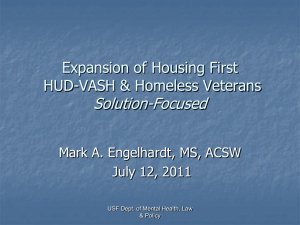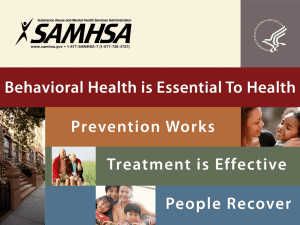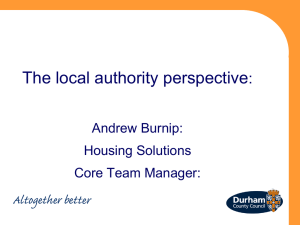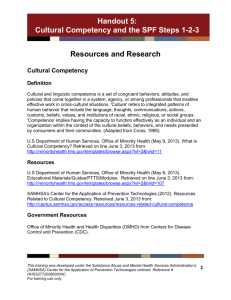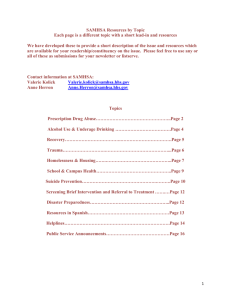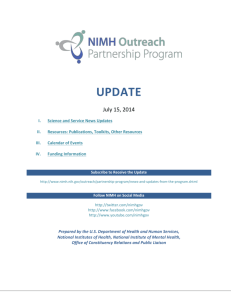Charlene Le Fauve, SAMHSA
advertisement
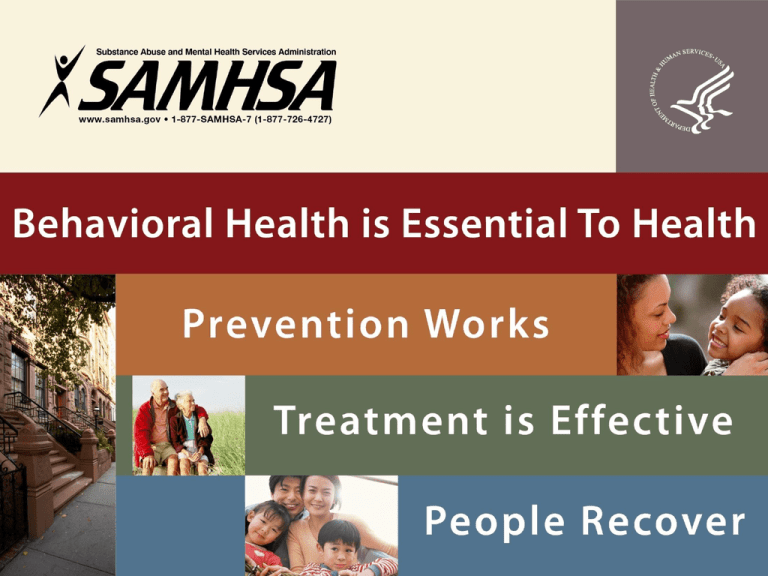
Overview of SAMHSA’s Housing Portfolio Charlene E. Le Fauve, Ph.D., Chief Co-Occurring and Homeless Activities Branch Center for Substance Abuse Treatment 2 SAMHSA’s 8 Strategic Initiatives • #1 – Prevention of Substance Abuse and Mental Illness • #2 – Trauma and Justice • #3 – Military Families • #4 – Recovery Support • #5 – Health Reform • #6 – Health Information Technology • #7 – Data, Outcomes, and Quality • #8 – Public Awareness and Support 3 8 Strategic Initiatives – Support Goals and Drive Efforts • Set budget and policy priorities. • Manage grants, contracts, technical assistance, agency staff, and interagency efforts. • Engage partners at every level. • Measure and communicate progress. 4 Recovery Support Strategic Initiative Home Permanent Housing Health Recovery, Health, Wellness Individuals and Families Purpose Employment and Education 5 Community Social Inclusion SAMHSA Portfolio • PATH-Projects for Assistance in Transition from Homelessness • SOAR-SSI/SSDI Outreach Access and Recovery • GBHI – Grants for the Benefit of Homeless Individuals • SSH-Services in Supportive Housing • CABHI-Cooperative Agreements for the Benefit of Homeless Individuals • Contracts-Technical Assistance 6 GOAL OF THE PATH PROGRAM Main goal of PATH is to support the delivery of eligible services to persons who are homeless and have serious mental illnesses and co-occurring substance use disorders, with a particular emphasis on • • • • • (a) adults, (b) persons who are literally homeless (c) street outreach (d) case management and (e) services which are not supported by mainstream mental health programs. SOAR • Purpose: SAMHSA has contracted to provide technical assistance to States as part of the Supplemental Security Income (SSI)/Social Security Disability Income (SSDI) Outreach Access and Recovery (SOAR) initiative and to evaluate the outcomes of the initiative. 8 SOAR Program Outcomes • Initial Application Decision: Since 2006, there have been 8,978 decisions on initial applications reported by 37 states; nearly 4,600 decisions in 2010. The approval rate of these applications was 73% in 91 days on average. • Economic stimulus: SSI/SSDI brought at least $53.1 million into the states and local economies of the 37 states reporting outcomes. • Serving individuals who are chronically homeless (16 states reporting): Persons served through SOAR have been homeless for an average of 2 years. • Increased access to housing (10 states reporting): 81% of applicants were housed by the time benefits were approved; the length of time to housing after benefits were approved averaged 39 days. 9 GBHI • Purpose: Grants for the Benefit of homeless Individuals (GBHI) program is designed to enable communities to expand and strengthen their treatment services for people experiencing homelessness who also have a substance abuse disorders, mental illness, or co-occurring disorder. 10 SSH • Purpose: The purpose of the Services in Supportive Housing (SSH) program is to help prevent or reduce chronic homelessness by funding mental health and substance abuse services for individuals and families experiencing chronic homelessness in coordination with existing permanent supportive housing programs and resources. 11 Grant-Making 12 Revised Approach to Grant-Making • Braided funding within SAMHSA & with partners • Engaging with States, Territories & Tribes – Flexibility • Funding for States to plan or sustain proven efforts • Encouraging work with communities • Leveraging resources across SAMHSA programs SAMHSA’S THEORY OF CHANGE 13 EVALUATION SURVEILLANCE WIDESCALE ADOPTION Medicaid IMPLEMENTATION Capacity Building Infrastructure Development TRANSLATION Implementation Science Demonstration Programs INNOVATION Proof of concept Services Research Practice-based Evidence Curriculum Development Policy Development Financing Models and Strategies DISSEMINATION Policy Change Technical Assistance Workforce Development Policy Academies Systems Improvement Practice Registries Social Media Publications Graduate Education SAMHSA Block Grants Medicare Private Insurance DOD/VA/DOL/DOJ/ED ACF/CDC/HRSA/IHS Ready for Change 14 Implementing a Theory of Change • Taking proven things to scale (PSH) • Researching/testing things where new knowledge is needed Efficient & Effective Use of Limited Dollars • Consolidating contracts & TA Centers • Consolidating public information & data collection activities and functions Regional Presence & Work with States CABHI • SAMHSA combined the current SAMHSA SSH program and the SAMHSA GBHI program to offer CABHI. • The previous SAMHSA SSH and GBHI programs combined housing assistance with intensive individualized support services to individuals who are chronically homeless and in need of mental health and substance abuse services. 15 CABHI • CABHI will serve chronically homeless individuals • Enhance infrastructure planning and development activities • Assist chronically homeless individuals and community service providers with enrollment in Medicaid and other mainstream programs. • Awards: Up to $500,000 per year for up to 3 years (approximately 13 new awards total) 16 Thank You • Contact Information: Charlene E. Le Fauve, Ph.D. SAMHSA Housing Portfolio Staff Lead Chief, Co-Occurring and Homeless Activities Branch Center for Substance Abuse Treatment Charlene.Lefauve@samhsa.hhs.gov 240-276-2787 17
